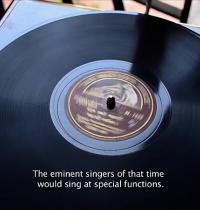Indira Biswas
Grant Period: Over two years
The radio and the gramophone have significantly altered the ways in which music is played and heard. Therefore, any attempt to research the evolution of Bengali music needs to look at how these forms of media have influenced and shaped music history. There have, however, been few attempts to look at these enmeshed histories despite there being considerable though mostly musicological work on particular aspects of Bengali music. Independent researcher, Indira Biswas, working on the history of Indian broadcasting, feels that the lacuna can be addressed by studying music in conjunction with media studies.
Gramophone records played a major role in shaping and reorganising the cultural domain of the Bengali middle class much before the advent of radio and film. In sharp contrast to radio broadcasting which had an explicit pedagogic agenda, the phenomenon of gramophone records began and continued as a commercial enterprise till the technology lost its market to more affordable technology like audio cassettes. The gramophone penetrated Bengali households quite extensively, and people in the villages also had an opportunity to listen to kaler gaan. It was primarily through gramophone records that people began to discover songs of lesser known musicians. Radio, however, began with experimental broadcasting in mid-1920. This was followed by systematic broadcasting with the establishment of the first broadcasting station in Mumbai in July 1927 and another station in Kolkata in August 1927. Needless to say, music was central to the histories of both––the radio and the gramophone––and the two technologies played a critical role in the development of regional songs during the first half of the twentieth century.
But radio as opposed to the gramophone implied fixed hours of daily broadcasting and called for systematic programming. A large number of performers had to be identified and recorded to fill a daily programme schedule through the year. This led to the emergence of a new group of singers, composers and lyricists, mostly middle class, and the terms, ‘professional’ and ‘amateur’ marked important shifts in the reorganisation of social and cultural practices. Ms Biswas is keen to prepare a list of singers, (especially women who made substantial contributions to Bengali music) performers, composers and lyricists with photographs and short notes in order to map the world of Bengali music in the early decades of the twentieth century. Ms Biswas is also fascinated by the cultural and pedagogic project of the radio that has influenced and formed Bengali middle-class taste.
Indira Biswas’s project locates the early years of the radio and the gramophone within a larger social and cultural history, while reading the history of Bengali music through the intersection of cultural policy, technology and a nascent market. She is attentive to the position that music occupied in the everyday life of Bengali middle-class families. Ms Biswas is quick to point out that the roles of the radio and the gramophone have to be mapped in relation to government aid to music schools (and the inclusion of music in the Calcutta University curriculum). The sources Ms Biswas will explore range from print and audio-visual records to programme content and publicity material pertaining to the radio and the gramophone. The project will result in an archive of print materials, a monograph in Bengali and a reader collating and annotating articles from Betar Jagat (1930-1950).





